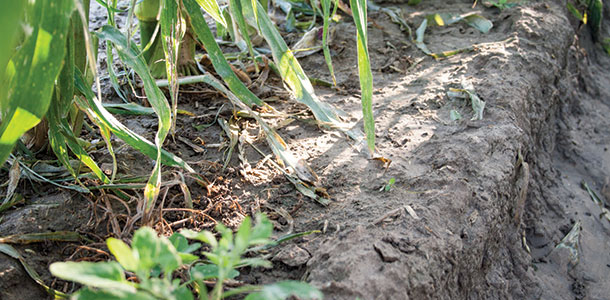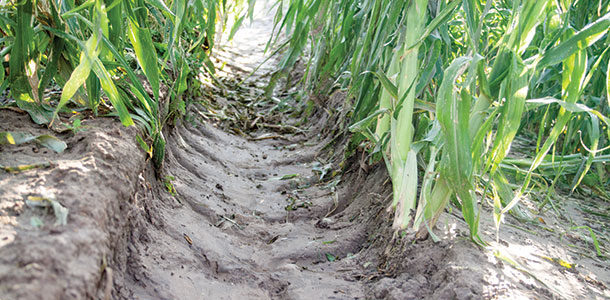Soil is the foundation upon which all agricultural operations are built. Whether it’s a crop traditionally harvested in the fall or a livestock operation that relies on forages for cattle, everything starts in the soil. With erosion and soil nutrient depletion being ever-present issues in the agriculture industry, it’s no wonder soil nutrition and management has become an increasingly hotter topic.
The U.S. has a wide variety of soils and climates, not to mention an equally wide array of products. Each producer needs to develop a plan that fits with his region and goals. Although management plans can be highly specific to that producer, there are right and wrong ways of doing it.
However, according to Jim Johnson, a soils and crop consultant at the Samuel Roberts Noble Foundation, every production plan should at least contain management practices for these four concerns: pH; nitrogen, phosphorus and potassium levels; organic matter and structure.
Soil pH
In a soil evaluation, Johnson checks the soil’s pH first. A soil’s nutrient solubility is dependent on its pH, meaning that if the soil is too basic or acidic, the crops planted there cannot absorb the nutrients.
The best and easiest way to treat a soil with a low or acidic pH is with an application of ag-lime or calcium carbonate. This compound will raise the pH and help to neutralize the soil acidity. Basic soils aren’t common but will also inhibit the soil’s nutrient solubility. This problem can be treated with elemental sulfur.

Neutral soils should still be tested regularly to ensure that neutrality is maintained. Soil tests should be conducted every one to three years depending on the soil’s productivity and the crops or forages grown.
Land used to grow high-value crops should be tested every one to two years, whereas pastureland only needs to be tested every three years. Producers should contact their local extension office for more detailed information on their area.
Soil nitrogen, phosphorus and potassium
After pH, Johnson would check the soil’s nitrogen, phosphorus and potassium levels. The producer’s goals will make this vary significantly. Johnson likens the nitrogen in the soil to gas in a car. If the producer wants to go far or have high crop yields, he’s going to need to add nitrogen to the soil to give his crops a boost.
Phosphorus and potassium are more like the oil in the car. Whether the car needs to go across town or across the country, it still needs to be above the line on the dipstick. Whether the producer plans for a bumper crop or wishes to maintain his soil, the phosphorus and potassium still needs to be present in the same quantities. Adding more of these two will not have the same effect as adding nitrogen does. Less than the necessary amounts, however, and there will be negative consequences.
While nitrogen will likely need to be added on a yearly basis, especially for high-production soils, phosphorus and potassium may only need to be monitored each year. This way the producer already has a plan should they become low.
Synthetic fertilizer is the most common solution for deficiencies in any of these nutrients. Organic materials such as compost, manure and biosolids are also an option for producers. Manure can be very effective.
However, the nutrients are in much lower concentrations than in commercial fertilizer. Consequently, unless the producer either owns livestock or there is a livestock operation nearby, this method of fertilization can be expensive.
High phosphorus levels are a concern for producers who use large amounts of manure to fertilize crops every year. Manure contains similar concentrations of phosphorus compared to nitrogen and potassium levels, but forages require less phosphorus than nitrogen and potassium. Consequently, over several years, the phosphorus levels can build up in the soil, causing problems. Producers should watch for this and manage accordingly.
Some producers plant other crops to help with their soil’s nutrient content. One method is the integration of legumes such as soybeans, alfalfa or clover added to a pasture or used in a crop rotation.
Legumes decrease the need for fertilizer by adding nitrogen back into the soil through nitrogen fixation. Some plants, like buckwheat, are able to convert insoluble phosphorus, which is inaccessible to most plants, into soluble phosphorus.
Producers are also using earthworms to convert inaccessible nutrients into accessible nutrients. These small invertebrates ingest the nutrients and excrete them in a form accessible to the plant.
Unlike the plant options for nutrient enrichment, earthworms are able to convert several different types of nutrients.
Soil organic matter
The amount of organic matter in soil is an indication of its nutrient holding and releasing capacity. In other words, it shows the soil’s ability to supply the crops with nutrients. To help maintain or increase organic matter, leave some residue or stubble on the surface of the soil after harvest.
In pasture situations, livestock need to be moved when there are still at least a few inches of forages left. Never graze or cut a pasture just above the ground. Always leave at least a couple inches of forages.
The roots are another important aspect for developing organic matter in the soil because they exude sugars into the soil, which are eaten by the micro-organisms living there. These micro-organisms eventually become organic matter either by dying or by being eaten by larger micro-organisms.
This recycles the soil’s nutrients in a way that is accessible to the plant.
To develop good root growth, and in turn, cultivate good micro-organism content, allow the plants time to rest in between cuttings or grazing. The general rule of thumb is: A plant’s root system is about the same size as its shoot system.
Keeping living plants or residue on the soil’s surface protects the micro-organisms. Soil can reach extremely hot temperatures during warm summer days.
The ideal soil temperature for these micro-organisms is between 70 and 80ºF. As the temperature increases, they will be less active and eventually go dormant, but 140ºF or higher will kill them.
Living plants are ideal, but any type of plant material on the soil will help keep the temperature down and preserve these micro-organisms. Colder temperatures will also cause them to go dormant, but Johnson is unaware of anywhere in the U.S. where soil temperatures drop low enough to kill them.
Soil structure
Although not directly related to soil nutrition, a soil’s structure affects its nutrient content and productivity. Covered soil, crop diversity and pasture rotation are key components to preserving soil structure.
Living plants or crop residue reduces erosion. Crop diversity varies the nutrients removed from the soil and encourages more diverse microbial life.
Rotation is the key word in “pasture rotation.” This could be rotating the use of the pasture each year or switching when it is grazed. For instance, producers who hay as well as graze should switch around which pastures are hayed and which ones are grazed each year. An additional step would be to vary the month in which the pasture is cut or grazed each year.
Producers with multiple types of livestock can also switch which livestock grazes each pasture, and those with one type should consider more intensive rotational grazing systems. Both of these systems will encourage even pasture grazing.
By switching the pasture’s use, producers can reduce the level of nutrient depletion from growing the same crop each year and limit soil compaction from driving large amounts of heavy equipment over the ground.
Johnson feels that next to water, soil management is the biggest challenge producers face. It isn’t something that can be bought in a bag and applied.
It’s something that takes time, knowledge and the patience to sit down and plan it out. Nevertheless, healthy soil is a vital component of any successful farming operation. Never underestimate its importance. FG
The information in this article was provided by Jim Johnson, a soils and crops consultant for The Samuel Roberts Noble Foundation in Oklahoma.
PHOTOS
TOP PHOTO: Soil nutrition is an important part of any plant-based operation. Erosion can also negatively impact plant performance.
BOTTOM PHOTO: The amount of organic matter indicates the soil’s ability to supply a crop with nutrients and feed the soil’s microorganisms. Microorganisms assist in breaking down plant material and recycling nutrients in a form accessible to the plant. Photos by Jenna Hurty.










